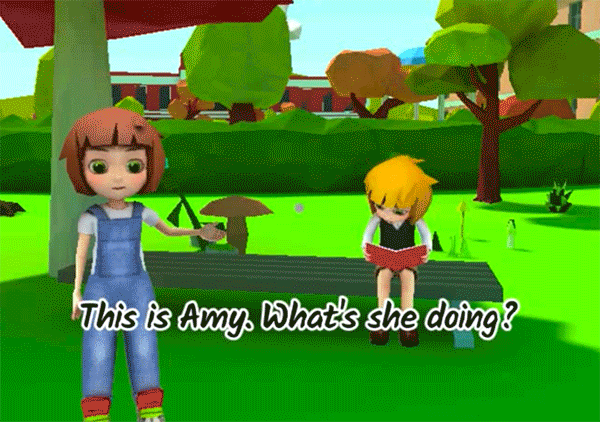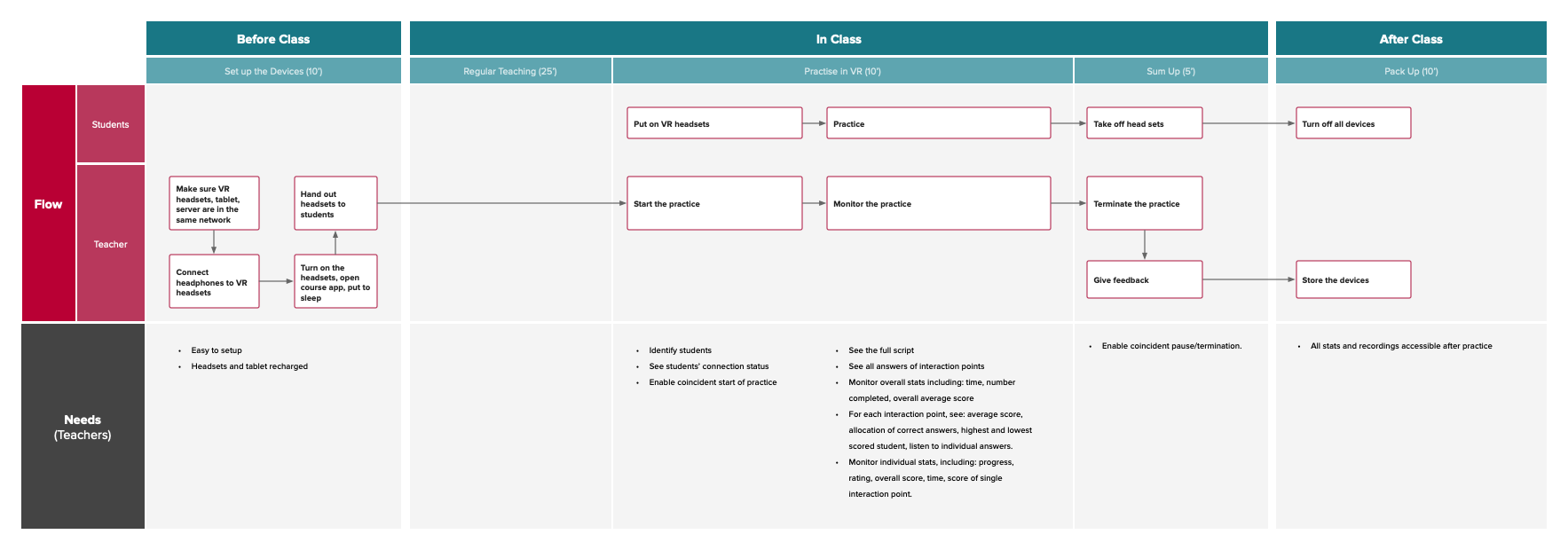VR English Class
VR English Class is a series of courses designed for Chinese primary school students to practice English speaking in immersive contexts. The bundle includes a mobile application that runs on tablets, allowing the teacher to monitor the real-time progress of each student who participates in the VR headset practice.
UX strategy
When I joined the team, I asked what kind of impact VR would have on language teaching and learning. How can we demonstrate its potential to schools and enhance teaching with a great product that also generates revenue for the company?
I helped define the value proposition of this product by focusing on the following benefits:
Everyone Speaks. Untethered standalone VR headsets make speaking practice accessible to every student, particularly in low teacher-to-student ratio classes in China.
Contextual Learning. VR courses increase the effectiveness of language learning by allowing students to apply what they learn in class to virtual environments and contexts.
Real-time Feedback. A central console is used to allow teachers to monitor the progress and real-time results of students who participate in VR courses.
The challenge
While the VR courses can operate independently on headsets, the company intends to develop the full in-class solution that demands several devices to be linked on the same network. Developing high-quality VR content requires significant effort, and designing the complete in-class experience for teachers and students adds another level of complexity to this project.
Develop a universal guideline
One of the ways I led the team in reducing complexity was by introducing a universal interaction guideline. The benefits of having a guideline include:
Enhance the immersive experience by creating familiarity and empathy for students with the characters and stories.
Reduce the learning curve for students and decrease the time required for teachers to prepare for classes.
Significantly increase communication efficiency and reduce development time.
Provide the marketing team with more consistent resources and language.
The process involves introducing a storyline that runs through the courses, recurring characters, scenes, and other 3D assets, as well as a consistent visual style, course structure, and interactions. The number of interactive points in each course varies depending on the course's difficulty level.
Some of the scenes that appear in the courses.
All courses follows the same structure and flow indicated above.
I worked with our internal teaching team to defined the course structure. Students can choose between two modes when they enter each course. 'Free Mode' is designed for individual practice, while 'Class Mode' enables connectivity so that practice data can be transmitted to the teacher's application on the tablet.
Each course consists of two parts: 'Listen and Repeat' and 'Story Play'. When in Class Mode, students are taken directly to 'Story Play' and must wait for the teacher's command to start the course.
Course UI library
Speech recognition done right
Most of the interactive elements in our courses involve speech recognition. Conversing with virtual characters is what makes our courses distinctive and effective for language learning.
Our initial approach was to emulate natural conversation, so speech recording activates automatically whenever the user is prompted to speak.
We found two main problems when we presented the prototype to a few teachers.
The conversational interaction was too challenging for the young students we were designing for.
Although the idea of emulating natural conversation is fascinating, the result falls short due to highly scripted dialogue and low polygon 3D models constrained by the hardware.
We have also learned that, although we hope people can speak in virtual reality as they do in the real world, teachers do not suggest this as the primary goal of these courses. In Chinese schools, academic results are prioritised over students' ability to use the language. Many teachers prefer students to have more control when practicing, such as the ability to listen to sample recordings and compare that with their own recordings.
We iterated the interaction pattern and introduced a 2-step tips system for students who don’t know to respond to a question.
After conducting A/B testing, we arrived at the final speech interaction. Although it did not initially showcase the value of VR as we had hoped, it ultimately proved to be the most effective approach for teachers and students.
Control, monitor and feedback
We designed the product with in-class usage in mind from day one, meaning that getting the VR content right is only half of the story. The teachers' experience is just as crucial as that of the students.
The hardware setup process was designed by the headset supplier, so there was no way around it. All we could do was provide a clear manual to help teachers manage the device and set it up with minimal effort.
Dual track user journey
We identified three key requirements for teachers when using the tablet centre control application:
Control. Select the VR courses and control the start and finish of the course.
Monitor. See the connection status and monitor the progress of each student.
Feedback. Listen to the students’ voice recordings and provide feedback and further instructions based on the overall and individual results.
There was a long list of features to consider. I worked with teachers and the development team to prioritize them for the initial release. Features such as displaying detailed individual results and transmitting voice recordings to tablets were developed in the second release.
Screenshots of the tablet app interface
VR has a long way to go
We successfully launched the product and demonstrated it in several open classes across different cities in China. The product was well-received by schools and officials from the educational department. It shed light on how language learning in virtual reality could be. The company sold the software and hardware bundle to several schools that were keen on complementing traditional teaching with experimental elements.
On the flip side, the technology struggled to advance. We were well aware of the state of VR at that time and knew that it would take many years to truly revolutionise the language learning experience. The headsets need to be lighter and more comfortable, the interaction could be more intuitive, and the cost of developing interactive VR content needs to decrease for industries like education to leverage its capability and challenge the traditional pursuit of academic excellence.





